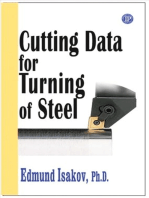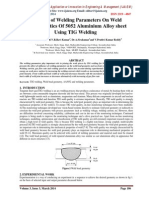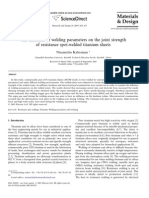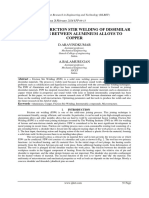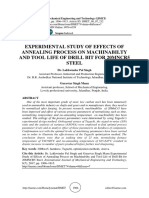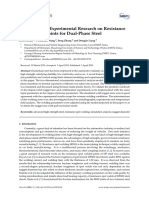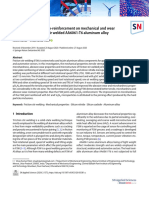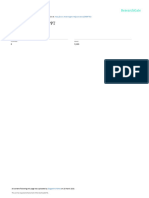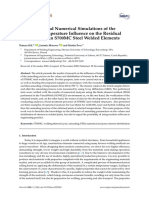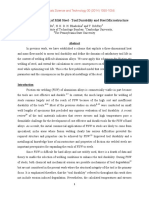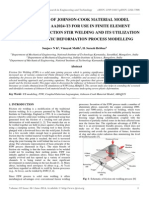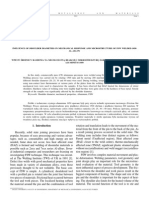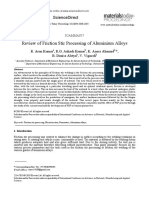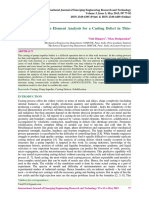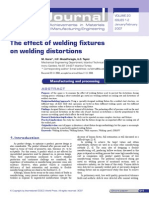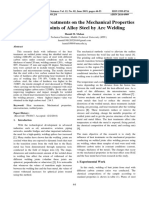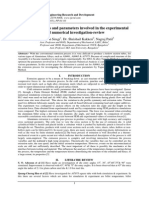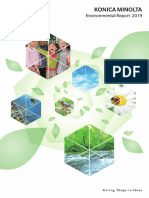Friction Welding of St-A1 and A1-Cu Materials
Friction Welding of St-A1 and A1-Cu Materials
Uploaded by
arun_prasath_41Copyright:
Available Formats
Friction Welding of St-A1 and A1-Cu Materials
Friction Welding of St-A1 and A1-Cu Materials
Uploaded by
arun_prasath_41Original Title
Copyright
Available Formats
Share this document
Did you find this document useful?
Is this content inappropriate?
Copyright:
Available Formats
Friction Welding of St-A1 and A1-Cu Materials
Friction Welding of St-A1 and A1-Cu Materials
Uploaded by
arun_prasath_41Copyright:
Available Formats
Journal of
ELSEVIER
Journal of Materials ProcessingTechnology49 (1995)431-443
Materials Processing Technology
Friction welding of St-A1 and A1-Cu materials
Bekir S. Yilba~ a'*, Ahmet Z. $ahin a, Nafiz K a h r a m a n b, A h m e d Z. A1-Garni a
aKing Fahd University of Petroleum and Minerals, Mechanical Engineering Department, Dhahran 31261, Saudi Arabia b Erciyes University. Engineering Faculty, Kayseri, Turkey
Received 26 May 1993;accepted 19 April 1994
Industrial Summary The present study investigates the mechanical and metallurgical properties of friction-welded steel-aluminium and aluminium-copper bars, a friction welder having been designed and built for this purpose. The effects of the three main parameters: speed of rotation; friction load; and duration of welding; on the metallurgical and mechanical properties of the weld such as the yield, tensile and breaking strengths, are studied experimentally and statistically. The metallurgical properties of the weld are examined using electron and optical microscopy.
1. Introduction Friction welding is classified as a solid-state welding process, in which joining occurs at a temperature below the melting point of the work metal. When melting occurs there is little evidence in the resulting welded end-product. Heat is generated by direct conversion of mechanical energy into thermal energy at the interface of the workpieces during the welding process. Friction welds are made by holding a nonrotating workpiece in contact with a rotating workpiece under gradually increasing pressure until the interface reaches the welding temperature, and then stopping rotation to complete the weld. The heat developed at the interface raises the temperature of the workpieces rapidly over a very short axial distance, to values approaching the melting range, welding occurring under the influence of the pressure that is applied when the heated zone is in the plastic temperature range. Friction welding can be achieved at high production rates and therefore is economical in operation, in applications where friction welding has replaced other joining processes, the production rate having been increased substantially [1]. Savings in material can be realized also by the use of friction welding, this being especially true *Corresponding author. 0924-0136/95/$09.50 ~(3 1995 ElsevierScienceS.A. All rights reserved. SSDI 0 9 2 4 - 0 1 3 6 ( 9 4 ) 0 1 3 4 9 - 6
432
B.S. Yilba~ et al. / Journal of Materials Processing Technology 49 (1995) 431-443
when joining large-diameter rotor bodies or other rotating members, or joining the components of valve systems I-2]. When welding dissimilar metals by friction welding, problems arise not only from the different hardnesses and melting points of the materials, but also from the possibility of interaction producing either brittle intermetallic phases or low meltingpoint eutectics [3]. In the aluminium/steel system, intermetallic compounds are a major problem, in general the formation of intermetallic phases being considered undesirable. Dawes [4] has introduced a relationship between the properties of joints and dissimilar materials which form brittle intermetallic compounds, and the time available for the formation of the compounds, concluding that satisfactory welds could be made if the welding conditions were such that the incubation period was longer than the weld time. However, the existence of an incubation period for intermetallic formation is questionable and control should be based on limiting the intermetallic thickness rather than on using an incubation period. The present study investigates the properties of friction welds for steel-aluminium and copper-aluminium bars, a friction welder having been designed and manufactured for this purpose. A temperature sensor is employed in the system to monitor the heating time and provide feed-back to the electronic controller. The number of parameters involved in friction welding is quite large, so that a statistical approach based on one-factor-at-a-time is tedious and unsatisfactory. Therefore, statistical design of the experiment based on factorial analysis is necessary. In the light of previous studies [5,6], the present work is extended to include the statistical analysis of the factors affecting the friction-welding process, these factors including speed of rotation, forging load and welding time. To achieve a complete block analysis, three levels of each factor have been selected. To investigate the mechanical properties of the dissimilar friction welds, tensile and micro-hardness testing of the resultant welds are carried out, metallurgical changes in the welding zone being studied also using SEM and optical microscopy.
2. Experimental
The rotating workpiece is driven by a 10 kW electric motor with a variable rotational speed of upto 3500 rpm maximum. In all tests the friction period is determined by a temperature rise in the welding zone, a controlling device activating the forging load and setting the duration when the temperature of the welding zone reaches the required value. Fig. 1 shows the experimental set-up employing the purpose-built friction welder [7]. In initial trials, a wide range of machine settings was explored, while maintaining many other parameters, i.e the cleanliness of the surfaces of the samples and the duration of the welding. It should be noted that each sample was cleaned before welding using acetone which ensure grease- and dirt-free surfaces. The aim was to explore the effects of different combinations of rotational speed, frictional load and temperature rise in the weld zone. A combination of the machine settings resulting in reproducible mechanical properties was selected for the remaining part of the study.
B.S. Yilba~ et al. / Journal of Materials Processing Technology 49 (1995) 431-443
Stabilizer Rotary jaw
433
! ~ I
Stationary
H y d r a r e u t c u i lr n
1~ Hydraulic ilh
r~
]~
n nl
Hydraulic Accumu ator (~ Gear pump
Tank
rllllllllllllllllllllllJlllllllllllllllllllllllllllJ f111111111
Fig. 1. Experimental set-up.
lllllllllllll
Friction Phase
Stopping Phase
Forge Phase
: :
, I
I
rce/
\
i
FrictionS~d : App,i Foroo
sp~ --/
I I
F ctionForc V
I I
I ~
:'\
I I
',
i
iq
Friction Time
', i
IIPI 1I
I
I I
i
I I
forge Time
ID
Stopping Time Fig. 2. Forge load characteristics.
The characteristics of the friction and the forge load are shown in Fig. 2. The factors explored, i.e. the speed of rotation, the friction and forge load and the duration of the welding process, and their levels, are given in Table. 1. To minimize the effect of organic contamination in the welding zone, the ends of the samples were cleaned prior to the welding operation. To investigate the metallurgical changes in the welding zone, samples were cut from different sections and mounted in perspex. SEM and Optical microscopy were used to analyze the metallurgical changes at the interface. Tensile testing and microhardness measurements of weld cross-sections are carried out to examine the mechanical properties of the resulting welds.
434
B.S. Yilba~ et al. / Journal of Materials Processing Technology 49 (1995) 431-443
Table 1 Weldingparameters and their levels Level 1 Speed of rotation (rpm) Applied load (kg) Weldingduration (s) 2000 5-12.74 4 Level2 Level 3
2500 2800 6.37 17.83 7.64-22.93 7 10
3. Factorial analysis
To investigate the effects of factors governing the friction welding process on the resultant weld properties, it was necessary to employ factorial analysis based on a statistical approach. In this case, the influence of each factor could be examined individually, together with that of their interactions. This required a complete factorial design, in which the selected factors were varied at appropriately selected levels. A mathematical model relevant to the present analysis is given in Appendix A. The responses considered in the factorial analysis included yield strength, tensile strength and breaking strength.
4. Discussion
The welding parameters of applied load for developing friction, speed of rotation and welding duration determine the thermal phenomenon occurring during the welding process. The cleanliness of the samples may be considered as secondary importance. Increased friction load secures a slight reduction of weld-zone temperature, with the consequent production of less intermetallic compound at the interface, whilst the forging load becomes important only when considering consolidation at the interface. When examining the effect of parameters on the resulting weld properties, it is observed that increasing the speed of rotation and the level of friction load during the heating period, gives deformation conditions that activate the contacting surfaces whilst also limiting the temperature/time conditions for joint heating, and consequently minimize the formation of intermetallics. There is no significant effect observed on the recorded parameters by changing the surface finish. Reduced surface cleanliness in terms of contaminants, especially grease, reduces the quality of the welded joint, consistent with the findings of earlier-reported work [8]. Discussions based on the resultant weld properties will be presented under two sub-headings, as follows.
4.1. Steel-aluminium welds
Tensile test results are shown in Fig. 3. Some of the welds show poor strength, which may occur due to some accumulation of alloying elements at the interface as
B.S. Yilba~ et al. / Journal of Materials Processing Technology 49 (1995) 431~43
1400
A
435
==
.C O~ C
1300
1200
Load applied
1100 5-12.74 kg 6.37-1783 kg 7.64-22.93 kg 1000 1800
I I I I
"0 0
>.
I
2800 3000
2000
2200
2400
2600
Speed (rpm)
1700 E 1600 1500 C
1400-
Load Applied
1300
e
5-12.74 kg 6.37-1783 kg 7.64-22.93 kg
1200
C
I-
1100 1800 1300
I
2000 2200 2400 2600 2800 3000
Speed (rpm)
==
1200 -
1100 Load Applied
e.
1000
/ dJ d
~ ~
5-12.74kg 6.37-1783 kg 7.64-22.93 kg
I
an
900 1800
I
3000
2000
2200
2400
2600
2800
Speed (rpm) Fig. 3. Tensile-test results (St-A1).
a result of temperature rise and the existence of intermetallic layers such as FeA1. An intermetallic thickness of 0.1-1 ktm is acceptable for the sound welds, above this value welds with low strength being produced. In the latter case, it is noted that the intermetallic layer is thick in the mid-radius of the weld, and thin at the center and
436
B.S. Yilba~ et al. / Journal of Materials Processino Technolooy 49 (1995) 431-443
400
I
Interface
"rW
A >
300
200
G) r=
lU
St 1 O0
]g~AI
-2
-1
Distance
(mm)
Fig. 4. Microhardness-test results (St-AI).
periphery of the weld, the relative absence of intermetallic layer at the center being consistent with the low relative velocity in this region. Microhardness test results are shown in Fig. 4, decrease in microhardness being noted in the steel zone. The width of the heat-affected zone is very small as compared to that for other thermal-welding processes. Microphotographs of the interface zone are shown in Fig. 5, in which it is observed that heavy deformation occurs at the interface. In this case, it is most probable that the aluminium oxide film is broken up, allowing the exposure of unaffected surface. As aluminium is relatively soft, this results in a large amount of deformation, so that surface contact at the interface should not be a significant problem. However, the stable aluminium oxide presents a barrier to bond formation, and consequently the times and temperatures required in diffusion is conductive to the formation and growth of intermetallics. It is found from Table 2 that the main effects of all the parameters on yield, tensile and breaking strengths are not significant. On the other hand, first-order interactions of these parameters have a significant effect on the tensile properties of the resulting welds. This may indicate that each factor has little individual effect on the tensile properties, but the coupling of friction load, speed of rotation and welding time has significant effect on these properties. In this case, it is difficult to make an assesment as to which parameter has a greater effect than the others on these properties.
4.2. Aluminium-copper welds
Tensile test results are shown in Fig. 6. Some joints failed due to the lack of bonding (i.e. very little bonding of aluminium on to the fracture faces of the copper) and the copper fracture faces show a pale grey aluminium layer, which may contain a considerable amount of intermetallic compound at the interface. When the speed of
B.S. Yilba~ et al. / Journal of Materials Processing Technology 49 (1995) 431-443
437
Fig. 5. Microphotography of the welding zone (St-A1).
438
B.S. Yilba~ et al. / Journal of Materials Processing Technology 49 (1995) 431-443
Table 2 Statistical effectsof weld parameters on mechanical properties for steel-aluminium welds Parameters Steel-aluminium Yield strength n P t
nxP nxt Pxt
Tensile strength 0.1 > 0.1 > 0.1 > 0.01 < 0.01 < 0.01 <
Breaking strength 0.1 > 0.1 > 0.1 > 0.1 > 0.1 > 0.1 >
0.1 > 0.1 > 0.1 > 0.01 < 0.01 < 0.01 <
rotation increases, micropores at the interface decrease, resulting in a homogeneous bond. In Fig. 7 microhardness test results are shown. Small changes occur in microhardness in the copper zone, which m a y be due to the comparatively high heat-transfer coefficient of copper. In Fig. 8, the microphotography of the Al-copper zone is shown, in which a resolved layer of intermetallic c o m p o u n d is seen to occur along the interface. A c o m p o u n d layer develops at the interface, the depth of which layer increases when the rotational speed increases and the friction load reduces. An increase in the c o m p o u n d layer results in p o o r mechanical properties. The smoothness of the copper face gives a good indication on bond integrity, since the bulk deformation is confined to the aluminium. Some defects occur at the interface and large particles of copper are embedded in the aluminium, showing the evidence of swirl flow in the aluminium. Statistical analysis show similar results to those obtained for steel-aluminium welds. Again, it is difficult to distinguish the effect of each individual parameter in the process. Coupling effects of friction load, speed of rotation and welding time on the tensile properties are significant. Table 3 shows the results of the statistical analysis.
5. Conclusions
The conclusions derived from the present work may be listed as follow.
5.1. S t e e l - a l u m i n i u m welds
1. Tensile properties improve for steel-aluminium welds when the intermetallic thickness extends only to 0.2-1 lam, above this value welds with poor strengths being produced. The intermetallic layer thickens at the mid-radius and becomes thin at the center and periphery of the weld.
B.S. Yilba~ et al. / Journal of Materials Processing Technology 49 (1995) 431-443
900
E
439
800
v
700
tJ
600 500 1 800
I
7.84-22.93 kg
I I ' I ' I
2000
2200
2400
2600
2800
3000
Speed lOO0
E t,b
v
(rpm)
9OO 8OO 7OO 6OO
J:
E~
} I--
500 1800
I 1
7.64-22.93 kg
I ' I I ' I '
2000
2200
2400
2600
2800
3000
Speed 900
E
(rpm)
800
v ..C
700
CB C
600
5-12.74 kg &37-1783 kg 7.64-22.93 kg
! I I I
"~
500 1 800
'
2000
2200
2400
2600
2800
3000
Speed
(rpm)
Fig. 6. Tensile-test results (AI Cu).
440
B.S. Yilba~ et al. / Journal of Materials Processing Technology 49 (1995) 431~143
80
I
Interface
-r >
70
J
1> AI
I
60
5O
Distance (mm)
Fig. 7. Microhardness-test results (AI-Cu).
2. The aluminium oxide film may be broken up, allowing the exposure of unaffected surface, which in turn results in increased deformation at the interface: this is the case which occurs at high friction loads and high speeds of rotation. On the other hand, the formation of an oxide layer causes a barrier and prevents diffusion. 3. The presence of contaminants at the interface of the metals the weld reduces joint quality, but there is no significant effect observed on weld properties by changing the surface finish. 4. The main effects of friction load, speed of rotation and welding duration are not significant when weld properties are concerned, but their interactions have a significant effect on these properties: this indicate strong coupling effects of these parameters on the resulting weld properties.
5.2. Aluminium-copper welds
1. A grey aluminium layer can be seen on the fracture faces of the samples, this layer containing a considerable amount of intermetallic compound at the interface. 2. The tensile properties improve for a particular thickness of intermetallic layer, the thickness of the intermetallic layer increases with speed of rotation and reduces with friction load. Further increase in the thickness of the intermetallic layer reduces the tensile properties. 3. When the speed of rotation increases, micropores at the interface decrease, which in turn results in a homogeneous bond. The smoothness of the copper face gives a good indication of bond integrity. 4. The effects of the main parameters, i.e. speed of rotation, friction load and duration of welding, are found to be less significant on the strength properties. However, the interactions of these parameters have a significant effect on these properties, which indicates that the effects of these parameters on the strength properties are coupled.
B.S. Y ilba~ et al. / Journal of Materials Processing Technology 49 (1995) 431-443
441
Fig. 8. Microphotography of the welding zone (A1-Cu).
442
B.S. Yilba~ et al. / Journal of Materials Processing Technology 49 (1995) 431-443
Table 3 Statistical effects of weld parameters on mechanical properties for a l u m i n i u m - c o p p e r welds Parameters Aluminium-copper Yield strength n P t nx P nx t Pxt 0.1 0.1 0.1 0.1 0.1 0.1 > > > < < < Tensile strength 0.1 > 0.1 > 0.1 > 0.01 < 0.01 < 0.01 < Breaking strength 0.1 0.1 0.1 0.1 0.1 0.1 > > > < < <
Appendix A. Mathematical modelling
The mathematical model governing the experimental analysis can be expressed as:
Xi, j, k = F i - -
ni
-- T k -- Fin j -- FiT k -
njT k -
ti, j , k ,
(A.1)
where xi, j,k is the response, ti, j,k is a common effect, Fi, nj, T k a r e the main effects of applied load, speed of rotation and welding time, F~nj, FiTk, njTk are the first-order interactions of relevant factors and t represents random error in the experiment, whilst i, j, k are the levels of applied load, speed of rotation and welding time, respectively. It should be noted that:
F i x n~ = n j x Fi,
(A.2)
this being valid for all interactions. To calculate the main effects of each factor and the effects of interaction, it is necessary to determine the mean corrected sum of squares of response at all levels of all factors. Noting that the sum of squares of each factor and the square of grand total should be calculated first. Due to the lengthy arguments, further mathematical analysis is not given here, but previous work [9] can be referred to. The significance levels of the effect of factors and interactions are obtained using an F-test.
References
I-1] T.J. Jessop and W.O. Dinsdale, Friction welding dissimilar metals, Proc. Conf. Advances in Welding Processes, Harrogate, 1978, The Welding Institute, paper 49. [2] R.A. Black, Friction welding cryogenic components for the JET project, Metal Construction, 15 (9) (1983) 574 576. I-3] N.I. Fomichev, The friction welding of new high-speed tool steels to structural steels, Svar Proiz, 27 (4) (1980) 26-28.
B.S. Yilba~ et al. / Journal of Materials Processing Technology 49 (1995) 431-443
443
1-4] C.J. Dawes, Micro-friction welding aluminium studs to mild steel plates, Metal Construction, 9 (5) (1977) 196-197. [5] K.G.K. Murti and S. Surdaresan, Parameter optimisation in friction welding dissimilar materials, Metal Construction, 15 (6) (1983) 331-335. [6] A.S.C. Ehrenberg, Data Reduction, Analysis and Interpreting Statistical Data, Wiley, London, 1975. I-7] N. Kahraman, Friction welding dissimilar metals and effects of weld parameters on friction welding, Ph.D. Thesis, Erciyes University, Turkey, 1992. [8] A.R. Laudern and P.L. Hurricks, Interaction of lubricants and materials, Trans. I. Marine Eng., 85 (1973) 1-7. [9] B.S. Yilbas, Study of affecting parameters in laser hole drilling of sheet metals, J. Eng. Mats. and Tech., 109 (1987) 282-287.
You might also like
- Accounts Payable (J60 - ES) : Test Script SAP S/4HANA - 18-09-20Document113 pagesAccounts Payable (J60 - ES) : Test Script SAP S/4HANA - 18-09-20Juan Ramón Cánepa RuizNo ratings yet
- Latest Developments in Friction Welding - A ReviewDocument6 pagesLatest Developments in Friction Welding - A ReviewIJRASETPublicationsNo ratings yet
- Influence of Welding Parameters On Weld Characteristics of 5052 Aluminium Alloy Sheet Using TIG WeldingDocument5 pagesInfluence of Welding Parameters On Weld Characteristics of 5052 Aluminium Alloy Sheet Using TIG WeldingInternational Journal of Application or Innovation in Engineering & ManagementNo ratings yet
- Rehabilitation of Automobile Crankshafts by Submerged-Arc WeldingDocument18 pagesRehabilitation of Automobile Crankshafts by Submerged-Arc WeldingeliiiiiiNo ratings yet
- The in Uence of Welding Parameters On The Joint Strength of Resistance Spot-Welded Titanium SheetsDocument8 pagesThe in Uence of Welding Parameters On The Joint Strength of Resistance Spot-Welded Titanium Sheetskaliappan45490100% (1)
- Materials Today: Proceedings: B. Elumalai, U. Omsakthivel, G. Yuvaraj, K. Giridharan, M.S. VijayanandDocument5 pagesMaterials Today: Proceedings: B. Elumalai, U. Omsakthivel, G. Yuvaraj, K. Giridharan, M.S. VijayanandYuvaraj RajuNo ratings yet
- Optimizing Tensile Strength of Low-Alloy Steel Joints in Upset WeldingDocument5 pagesOptimizing Tensile Strength of Low-Alloy Steel Joints in Upset Weldingabraham silva hernandezNo ratings yet
- Effect of Welding Current On The Mechanical and StructuralDocument8 pagesEffect of Welding Current On The Mechanical and StructuralBhramandhikaNalendraGhuptaNo ratings yet
- Heat Transfer Analysis During Friction Stir Welding of Al6061-T6 AlloyDocument8 pagesHeat Transfer Analysis During Friction Stir Welding of Al6061-T6 AlloyfabiskrujaNo ratings yet
- Ahmad Zadeh 2011Document15 pagesAhmad Zadeh 2011TapasNo ratings yet
- Pipeline InspectionDocument7 pagesPipeline InspectionSaulo RoseiraNo ratings yet
- Titipan ZahraDocument7 pagesTitipan ZahraDikaAfriandiNo ratings yet
- FSW Welding PresentationDocument56 pagesFSW Welding PresentationMazharNo ratings yet
- A Review On Friction Stir Welding of Dissimilar Materials Between Aluminium Alloys To CopperDocument7 pagesA Review On Friction Stir Welding of Dissimilar Materials Between Aluminium Alloys To CopperInternational Journal of Latest Research in Engineering and TechnologyNo ratings yet
- 39IJMPERDAPR201939Document8 pages39IJMPERDAPR201939TJPRC PublicationsNo ratings yet
- 50IJMPERDFEB201950Document8 pages50IJMPERDFEB201950TJPRC PublicationsNo ratings yet
- Experimental Study of Effects ofDocument10 pagesExperimental Study of Effects ofqonita.smart02No ratings yet
- Microstructural and Mechanical Properties of Double-Sided MIG, TIG and Friction Stir Welded 5083-H321 Aluminium AlloyDocument9 pagesMicrostructural and Mechanical Properties of Double-Sided MIG, TIG and Friction Stir Welded 5083-H321 Aluminium AlloydietersimaNo ratings yet
- Research Paper FSWDocument10 pagesResearch Paper FSWsahith palikaNo ratings yet
- ÖDEV Materials-12-01108Document16 pagesÖDEV Materials-12-01108Serkan APAYNo ratings yet
- Analyzing The Effect of Cutting Parameters On Surface Roughness and Tool Wear When Machining Nickel Based Hastelloy - 276Document11 pagesAnalyzing The Effect of Cutting Parameters On Surface Roughness and Tool Wear When Machining Nickel Based Hastelloy - 276Antonius Adi Hendra SaputraNo ratings yet
- Effect of Sic/Si N Micro Reinforcement On Mechanical and Wear Properties of Friction Stir Welded Aa6061 T6 Aluminum AlloyDocument11 pagesEffect of Sic/Si N Micro Reinforcement On Mechanical and Wear Properties of Friction Stir Welded Aa6061 T6 Aluminum AlloyKashif AlimNo ratings yet
- Mmech AprilDocument6 pagesMmech AprilVidyut KumarNo ratings yet
- Summary FSWDocument26 pagesSummary FSWhazelmyaNo ratings yet
- Friction Stir Welding of Austenitic Stainless Steels: of Achievements in Materials and Manufacturing EngineeringDocument8 pagesFriction Stir Welding of Austenitic Stainless Steels: of Achievements in Materials and Manufacturing EngineeringUsman RasheedNo ratings yet
- Process Parameters Optimization For Friction Stir Welding of RDE-40 Aluminium Alloy Using Taguchi TechniqueDocument7 pagesProcess Parameters Optimization For Friction Stir Welding of RDE-40 Aluminium Alloy Using Taguchi TechniquePunEit SinghNo ratings yet
- Sensitivity Analysis of Process Parameters On TensDocument11 pagesSensitivity Analysis of Process Parameters On TensGabriel IriminNo ratings yet
- 10452-Article Text-38608-44007-10-20240930Document21 pages10452-Article Text-38608-44007-10-20240930Ashish TomNo ratings yet
- Friction Stir Welding PP TDocument56 pagesFriction Stir Welding PP TSantosh V HiremathNo ratings yet
- Microstructure Analysis of Arc Welded Mild Steel Plates: IOP Conference Series: Materials Science and EngineeringDocument7 pagesMicrostructure Analysis of Arc Welded Mild Steel Plates: IOP Conference Series: Materials Science and EngineeringAniekanNo ratings yet
- Effect of Pouring Temperature and Stirring Speed OnDocument6 pagesEffect of Pouring Temperature and Stirring Speed OnInternational Journal of Research in Engineering and TechnologyNo ratings yet
- 8th Sem Project ReportDocument55 pages8th Sem Project ReportPrathmeshBhokari100% (2)
- Friction Stir Welding Process Parameters Significance and Impact On Metal Matrix Composites Joints: A Brief ReviewDocument12 pagesFriction Stir Welding Process Parameters Significance and Impact On Metal Matrix Composites Joints: A Brief ReviewPerumalla Janaki RamuluNo ratings yet
- Verification of Johnson-Cook Material Model Constants of Aa2024-T3 For Use in Finite Element Simulation of Friction Stir Welding and Its Utilization in Severe Plastic DeformationDocument5 pagesVerification of Johnson-Cook Material Model Constants of Aa2024-T3 For Use in Finite Element Simulation of Friction Stir Welding and Its Utilization in Severe Plastic DeformationInternational Journal of Research in Engineering and TechnologyNo ratings yet
- Lázaro Plata 2020 J. Phys. Conf. Ser. 1587 012034Document8 pagesLázaro Plata 2020 J. Phys. Conf. Ser. 1587 012034fernandoNo ratings yet
- RESID. STRESS - Experiments and Numerical Simulations of The Annealing Temperature Influence in S700MCDocument26 pagesRESID. STRESS - Experiments and Numerical Simulations of The Annealing Temperature Influence in S700MCGabriel PaesNo ratings yet
- Study On Effect of Manual Metal Arc Welding Process Parameters On Width of Heat Affected Zone (Haz) For Ms 1005 SteelDocument8 pagesStudy On Effect of Manual Metal Arc Welding Process Parameters On Width of Heat Affected Zone (Haz) For Ms 1005 SteelIJMERNo ratings yet
- MetalurgiaDocument5 pagesMetalurgiaViviana Contreras CzNo ratings yet
- Machine Design, Vol.5 (2013) No.1, ISSN 1821-1259 Pp. 1-10Document10 pagesMachine Design, Vol.5 (2013) No.1, ISSN 1821-1259 Pp. 1-10Sirajuddin ANo ratings yet
- Durability de MST 2014Document19 pagesDurability de MST 2014irfankohaaNo ratings yet
- A Review On Various Welding TechniquesDocument7 pagesA Review On Various Welding TechniquesIJMER100% (1)
- Microporosity Control and Thermal-Fatigue Resistance of A319 Aluminum Foundry AlloyDocument8 pagesMicroporosity Control and Thermal-Fatigue Resistance of A319 Aluminum Foundry AlloyAdriene SantosNo ratings yet
- Join Al Cu (Mumin Sahin) PDFDocument8 pagesJoin Al Cu (Mumin Sahin) PDFAgusWahyuWibowoNo ratings yet
- Murshid Imam-2017Document22 pagesMurshid Imam-2017Shine KunnathNo ratings yet
- Materials Science and Engineering ADocument9 pagesMaterials Science and Engineering AСергей СкргейNo ratings yet
- Verification of Johnson-Cook Material Model by Sanjeev N KDocument5 pagesVerification of Johnson-Cook Material Model by Sanjeev N KSanjeev NkNo ratings yet
- Roll Bonding Properties of Al/Cu Bimetallic Laminates Fabricated by The Roll Bonding TechniqueDocument10 pagesRoll Bonding Properties of Al/Cu Bimetallic Laminates Fabricated by The Roll Bonding Techniqueamalendu_biswas_1No ratings yet
- (Elearnica) - Effect - of - Welding - Parameters - On - Mechanical - and - Microstructural - Properties - o PDFDocument8 pages(Elearnica) - Effect - of - Welding - Parameters - On - Mechanical - and - Microstructural - Properties - o PDFelmiraNo ratings yet
- I. Uygur: Influence of Shoulder Diameter On Mechanical Response and Microstructure of FSW Welded 1050 Al-AlloyDocument8 pagesI. Uygur: Influence of Shoulder Diameter On Mechanical Response and Microstructure of FSW Welded 1050 Al-Alloyanandvijay02No ratings yet
- A Study On Rotary Friction Welding of Titanium AllDocument10 pagesA Study On Rotary Friction Welding of Titanium AllmadhukarNo ratings yet
- Friction Stir Processing PDFDocument7 pagesFriction Stir Processing PDFYazid HelalNo ratings yet
- Study On Effect of Manual Metal Arc Welding Process Parameters On Width of Heat Affected Zone (Haz) For Ms 1005 SteelDocument8 pagesStudy On Effect of Manual Metal Arc Welding Process Parameters On Width of Heat Affected Zone (Haz) For Ms 1005 SteelAngga Pamilu PutraNo ratings yet
- 01-The Effects of Gas Tungsten Arch Welding On The Corrosion and Mechanical Properties of AA 6061 T6Document12 pages01-The Effects of Gas Tungsten Arch Welding On The Corrosion and Mechanical Properties of AA 6061 T6hamidouNo ratings yet
- Hot Deformation Studies of AISI 1035 Steel Using Thermo Mechanical SimulatorDocument6 pagesHot Deformation Studies of AISI 1035 Steel Using Thermo Mechanical SimulatorIsrar EqubalNo ratings yet
- Modeling and Finite Element Analysis For A Casting Defect in Thin-Wall StructuresDocument6 pagesModeling and Finite Element Analysis For A Casting Defect in Thin-Wall StructuresSeethaNo ratings yet
- Effect of Welding FixturesDocument4 pagesEffect of Welding FixturesNanda KumarNo ratings yet
- Effect of Heat Treatments On The Mechanical Properties of Welded Joints of Alloy Steel by Arc WeldingDocument10 pagesEffect of Heat Treatments On The Mechanical Properties of Welded Joints of Alloy Steel by Arc WeldingFiras RocktNo ratings yet
- Characterization of Elevated Temperature Mechanical Properties of Butt-Welded Connections Made With HS Steel Grade S420MDocument6 pagesCharacterization of Elevated Temperature Mechanical Properties of Butt-Welded Connections Made With HS Steel Grade S420MzhangjlNo ratings yet
- A1160103 PDFDocument3 pagesA1160103 PDFIJERDNo ratings yet
- Mechanical Properties and Performance of Engineering Ceramics and Composites XIFrom EverandMechanical Properties and Performance of Engineering Ceramics and Composites XIJonathan SalemNo ratings yet
- E2019 EngDocument106 pagesE2019 EngAnonymous YLI2wFNo ratings yet
- GasPipelineSafetyOIR Plea PGE 20131018 288765atch04 288769Document12 pagesGasPipelineSafetyOIR Plea PGE 20131018 288765atch04 288769mah_abdelaalNo ratings yet
- Fpga Based Object Tracking System: Project ReportDocument12 pagesFpga Based Object Tracking System: Project ReportAchraf El aouameNo ratings yet
- If Today You Listen To His Voice Psalm 94Document1 pageIf Today You Listen To His Voice Psalm 94IvyMarie LaCorda-CabilloNo ratings yet
- Queen International School 2 Term Exam 2023 - 2024 Grade 1Document9 pagesQueen International School 2 Term Exam 2023 - 2024 Grade 1alaa.eyad.sulaiman77No ratings yet
- Balki 2014Document6 pagesBalki 2014Tito Adi SuryantoNo ratings yet
- Eliran Oved - The Melody of The Enchanted Forest + BonusDocument23 pagesEliran Oved - The Melody of The Enchanted Forest + Bonuseliranoved0No ratings yet
- PBMA Act - 2011Document20 pagesPBMA Act - 2011greydavid949No ratings yet
- Phonetics Words Minimal PairsDocument153 pagesPhonetics Words Minimal PairsSAHIL GUPTANo ratings yet
- Problems and Prospects of Street Vendors: A Study With Reference To Visakhapatnam CityDocument18 pagesProblems and Prospects of Street Vendors: A Study With Reference To Visakhapatnam CityAnsari faizan ahmedNo ratings yet
- IMEC IntroductionDocument2 pagesIMEC Introductionatul4uNo ratings yet
- The Speed of Light and The Index of RefractionDocument13 pagesThe Speed of Light and The Index of RefractionFaith MagluyanNo ratings yet
- Grey Kangaroo - Cangurul Lingvist-Engleza Martie 2022 - TEST ANTRENAMENT 6Document6 pagesGrey Kangaroo - Cangurul Lingvist-Engleza Martie 2022 - TEST ANTRENAMENT 6MOCANUNo ratings yet
- Prefixes & SuffixesDocument6 pagesPrefixes & SuffixesLuminita DragomirNo ratings yet
- Iveco Stralis Fuse Box DiagramDocument5 pagesIveco Stralis Fuse Box DiagramCatherine NansambaNo ratings yet
- Nasir,+667 Article+Text 2983 1 11 20210216Document5 pagesNasir,+667 Article+Text 2983 1 11 20210216kaoutarNo ratings yet
- Assessment 2 - Bernard Tschumi Transcripts - by Lim - Alexander - 3180281 - MediumDocument4 pagesAssessment 2 - Bernard Tschumi Transcripts - by Lim - Alexander - 3180281 - MediumpauloNo ratings yet
- Plants vs. Zombies Seeds of Destiny RulebookDocument111 pagesPlants vs. Zombies Seeds of Destiny Rulebookcurios8vNo ratings yet
- Thermo Ramsey EngDocument13 pagesThermo Ramsey EngSebastian NarvaezNo ratings yet
- Chlorides and SulphatesDocument4 pagesChlorides and SulphatesRESHMYNo ratings yet
- Two Marks Q&A Unit - I: CO BeoDocument21 pagesTwo Marks Q&A Unit - I: CO BeoReddyvari VenugopalNo ratings yet
- Yeasin Arafat: Career ObjectivesDocument2 pagesYeasin Arafat: Career ObjectivesAraf AhmedNo ratings yet
- Classification of AppetizerDocument48 pagesClassification of AppetizerArgelyn PedernalNo ratings yet
- Statistical MechanicsDocument18 pagesStatistical MechanicsKaren MorenoNo ratings yet
- FluentDocument26 pagesFluentMurshed UddinNo ratings yet
- An Evaluation of The Translation of The Film Rio Based On Newmark's ModelDocument12 pagesAn Evaluation of The Translation of The Film Rio Based On Newmark's ModelDương ThùyNo ratings yet
- Biodiversity, Tribal Knowledge and Life in IndiaDocument10 pagesBiodiversity, Tribal Knowledge and Life in IndiaHarsh DixitNo ratings yet
- Allied 3the Declaration of Independence - 220816 - 220352Document51 pagesAllied 3the Declaration of Independence - 220816 - 220352Adman AlifAdmanNo ratings yet
- 10 Shockingly Simple, Life-Changing Principles of Spiritual AwakeningDocument4 pages10 Shockingly Simple, Life-Changing Principles of Spiritual AwakeningAnonymous 0PYZofvGSNo ratings yet

